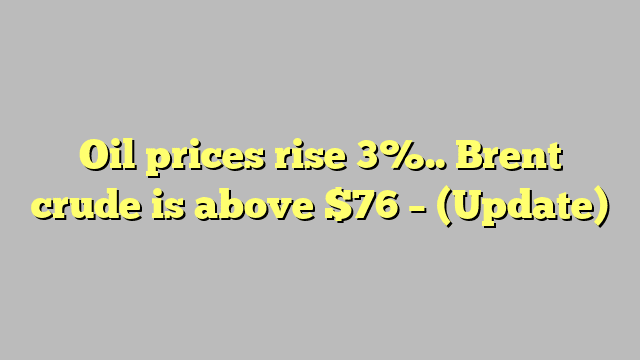Oil prices rose by about 3% at the end of trading today, Wednesday, July 5 (2023), with Saudi Arabia confirming that it will do what is necessary to support the market, indicating the possibility of approving more production cuts.
During the last session, the markets witnessed a recovery, after Saudi Arabia and Russia announced that they would extend production cuts until August.
And Saudi Arabia announced, on Monday, July 3, the extension of the additional oil production cut by one million barrels per day, for another month, during next August, with the possibility of extending it, and then followed by Russia’s decision to voluntarily reduce oil exports by 500 thousand barrels per day during The same month, to support the stability and balance of the global market.
Oil prices today
At the end of the session, Brent crude futures – for September 2023 delivery – rose 0.5%, to reach $76.65 a barrel, after rising $1.6 yesterday, Tuesday.
On the other hand, US West Texas Intermediate crude futures – for August 2023 delivery – rose by 2.9%, to $ 71.79 a barrel, compared to Monday’s close, as they were traded during a holiday in the United States to celebrate Independence Day, yesterday, Tuesday, without settlement.
And oil prices ended their dealings, yesterday, Tuesday, July 4, with the support of Saudi Arabia’s decision to extend the voluntary production cut of one million barrels per day for an additional month, according to the figures monitored by the specialized energy platform.
Oil price analysis
“Oil prices have come under pressure again, due to persistent concerns about a global economic slowdown and rising interest rates in the US and Europe,” said Tomomichi Akuta, chief economist at Mitsubishi UFJ Research.
“The market is likely to continue to go back and forth for some time, with focus on economic indicators in China and monetary policy of central banks,” he added, expecting Brent crude to trade around $75 a barrel.

A survey of the private sector showed, on Wednesday, that the service activity in China expanded at the slowest pace in 5 months in June, as weak demand affected the momentum of the post-epidemic recovery.
Saudi cut
Production cuts announced by Saudi Arabia and Russia on Monday lifted the market only briefly, amid concerns about weaker demand and further interest rate hikes, which could lead to an economic slowdown and reduce fuel demand further.
Saudi Arabia, the world’s largest crude exporter, said on Monday that it would extend the voluntary production cut of 1 million barrels per day until August, while Russia and Algeria volunteered to reduce their production and export levels in August by 500,000 barrels per day and 20,000 barrels per day, respectively. .
OPEC + – an alliance that includes the Organization of the Petroleum Exporting Countries and allies including Russia, and pumps about 40% of global crude – has cut oil production since November in the face of market volatility.
demand for oil
Investors remained concerned about oil demand, however, after business surveys showed a slowdown in global factory activity, due to sluggish demand in China and Europe.
Traders will look for demand cues from industry data on US crude oil and product inventories from the American Petroleum Institute later on Wednesday, and official data from the Energy Information Administration on Thursday, both of which were delayed by a day due to the US holiday.
And 4 analysts expected, in a Reuters poll, that US oil inventories would decline by about 1.8 million barrels in the week ending June 30, which would represent the third consecutive week of declines.
“The path of global oil inventories may soon become as important as the OPEC+ supply cuts themselves and the overall headwinds, given the International Energy Agency’s forecasts for oil market tightening in the second half of 2023,” analysts from the Commonwealth Bank of Australia said in a note.

Leave a Reply